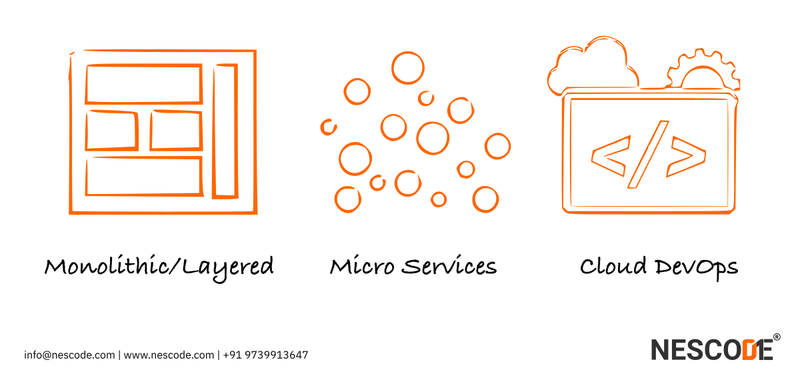Cloud-native architecture is more like an approach rather than an architecture for building software as microservices and running them on a containerized environment. The primary goal of following a cloud-native architecture is to take advantage of the cloud computing model and deliver software as a service. Therefore, cloud-native is more like how applications are created, deployed and maintained irrespective of the type of cloud platform such as the public, private and hybrid cloud. An application that follows a cloud-native approach are loosely coupled module, optimized to scale and perform use managed services and take advantage of continuous delivery to achieve reliability.
The company needs to adopt the cloud-native approach since speed, scalability and performance are the key parameters for startups to enterprise. Especially, when it comes to product development roadmap, milestones are designed for the long term and millions of users, therefore, adopting a scalable model makes more sense. The developer associated with a cloud-native building approach are primarily focus on something that has more adaptability and resilience such as microservices, container, CI/CD etc. Leading software solution providers leveraging the cloud-native approach even for the hardcore desktop application. Like we mentioned, cloud-native applications are designed as loosely coupled microservices, where each service running in their process and communicating using protocols like HTTP.
Earlier approach of development was more aligned as per desktop application where scalability, flexibility and delivery model was not as per today’s requirement. Since scalability, flexibility, usability and user expectation has changed over time, it is important to leap the development approach. In a cloud-native approach, services are developed using the language and framework best suited for the functionality. Just to take an example, the developer makes build real-time streaming services based on WebSockets, developed in Node.js, python for machine learning-based service and graphQL, rest framework for exposing the REST APIs. The precise approach to develop services allows developers to choose the best language and framework for a specific job.
Services built using cloud-native approach use lightweight APIs that are based on protocols such as representational state transfer (REST) to expose their functionality. Internal services communicate with each other using binary protocols for better performance. The cloud-native development approach is an extension of earlier what we used to follow. This approach is a way forward to enable the most robust, scalable and usable products and services.
At a high level, a cloud-native approach means adapting to the new possibilities inline with the cloud offering. Consider the high-level elements that a software architect are trained to consider - functional requirements of a system, non-functional requirements of a system and constraints. A well-architectured software should be largely self-healing, cost-efficient, easily updated and maintained through Continuous Integration/Continuous Delivery(CI/CD) model.
Cloud-native application is designed for automation and cloud makes it easier than ever to automate the infrastructure as well as components. In this particular approach, the developer always plays with “state”. Storing of state, be the user data(e.g the items in the users shopping cart) or system state such as how many instances of a job are running, what version of code is running in production is the hardest aspect of architecting a distributed cloud-native architecture.

Cloud is more than just infrastructure, most cloud service providers offer a rich set managed services which allow developers to use services without managing the underlying infrastructure. And using these managed services, a developer can scale the application at any point of time whether it is managed open source or open source-compatible services.
If we talk from a commercial point of view, cloud servers are charged based on usage means software publisher can save money by reducing the footprint. And since, its use microservices, it’s much easier to scale up and scale down based on requirements.
Before we conclude, let’s discuss the advantage of cloud-native approach over the traditional model. There are various underlying elements are there that make this approach unique, few of them are as follows:
Stateless and massively scalable: A cloud-native application stores its state in a database or some other external entity. This gives liberty to any instance to process a request, they are not tied to the underlying infrastructure which allows the application to run in a highly distributed manner and still maintain its state-independent.
Resiliency at the core of the architecture: When we use a distributed model, failure will happen at the hardware level, application level or maybe at the network level. Resiliency is the ability of a system to recover from failure and continue to function. It’s not about avoiding the failure but an approach to failure in a way to avoid downtime or data loss. To implement resiliency, a developer can use the following strategies:
Orchestrated lightweight containers: Containers make it possible to isolate applications into a small lightweight environment that share the operating system kernel. Compared to a virtual machine, containers use much lesser resources and start-up almost immediately. Docker has become the standard for container technology and the biggest advantage they offer is the portability.
Agile DevOps and automation: DevOps describes the organizational structure, practice and culture needed to enable rapid agile development, scalable and reliable operations. At Nescode, we consider DevOps as the collaborative practice and automation that aligns development and operations team and bring on one page to improve customer experiences.
Considering the above flexibility and approach, we can say cloud-native development is the way forward to develop next-generation products and services.
Startups, SMBs and enterprise are moving to cloud to stay agile, flexible and competitive. But above all, they want cloud without risking business disruption, security, compliance and performance. In such a case, a cloud-native development strategy is the only way forward to leverage the cloud and managed services in the best possible way.